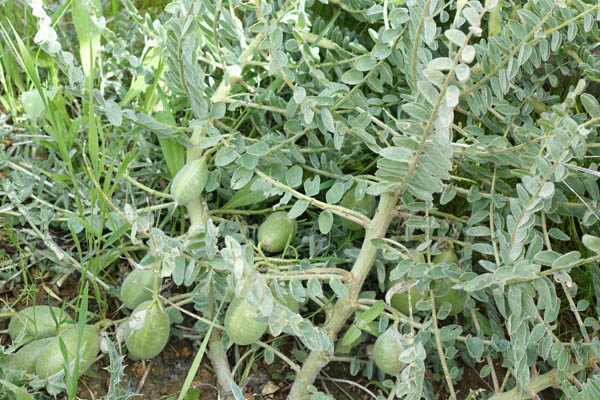Astragalus gileadensis, Astragalus postii, Aleppo milk-vetch,
Hebrew: קדד פיינברון, Arabic: القتاد الحلبي
| Scientific name: | Astragalus aleppicus Boiss. | |
| Synonym name: | Astragalus feinbruniae Eig, Astragalus galilaeus Freyn & Bornm., Astragalus gileadensis Eig, Astragalus postii Eig | |
| Common name: | Aleppo milk-vetch | |
| Hebrew name: | קדד פיינברון | |
| Arabic name: | القتاد الحلبي | |
| Family: | Fabaceae or Papilionaceae, Legume/Pea Family, הפרפרניים |

Location: Pura Nature Reserve |
| Life form: | Hemicryptophyte | |
| Stems: | Not climbing | |
| Leaves: | Alternate, compound, pinnate, leaflets 12-25 pairs, ovate to orbicular, smooth margin; stipules lanceolate to linear-subulate | |
| Inflorescence: | Racemes sessile, 1-4-flowered | |
| Flowers: | Peduncles 4-7mm long, bracts 18-22mm long, calyx 20-22mm long, teeth 2-5mm long, corolla whitish to yellow, teeth lanceolate-subulate, one-third as long as tube; keel somewhat longer than wings | |
| Fruits / pods: | Legume 25-35 x 15-20 mm, ovoid Pods pubescent deflexed, oblong, flattened, netted-wrinkled, ending in a straight beak | |
| Flowering Period: | March, April, May | |
| Habitat: | Shrub-steppes | |
| Distribution: | Mediterranean Woodlands and Shrublands, Semi-steppe shrublands, Shrub-steppes | |
| Chorotype: | Irano-Turanian | |
| Summer shedding: | Ephemeral |

Location: Pura Nature Reserve Derivation of the botanical name: Astragalus, ἀστραγαλος, literally signifies a huckle bone (talus), a small bone of the ankle; astragalus, which the Greeks, as well as the Romans, used for dice and other purposes and an early name applied to some plants in this family, with vertebra-like knotted roots. aleppicus of Halab (Aleppo), N Syria. feinbruniae, for Naomi Feinbrun-Dothan (1900 – 1995), an Israeli botanist. galilaeus, of Galilee. gileadensis, of Gilead. postii, named in honour of the American botanist George Edward Post (1838–1909). The Hebrew word: קדד, kedad, related to Akkadian (the earliest attested Semitic language; qadādu (= to lean, bend, incline), from Arabic qudad.

Location: Pura Nature Reserve |